"I tried content marketing, but it didn't work."
I can't tell you how many times I've heard that excuse. In fact, if I had a nickel for every time a business owner has told me that, I'd have enough to run a content marketing campaign that proves them wrong.
The truth is, marketing never works if you don't have a clear goal, direction, and target audience.
It's like saying, "I tried Google Maps, but it didn't work," without ever having entered an address.
People often get the goal part right; we are usually pretty clear on what we want. But where they often fall over is in creating a direction for their marketing campaigns and one that targets a specific audience.
That specific audience part is crucial. Even simply targeting 'a specific audience' isn't going to deliver the goods, you need to be speaking to 'your specific audience.' So how do you know who your audience is?
That's where marketing personas come in.
What Is a Persona in Marketing?
What is a marketing persona? The question is on everyone's mind. So, let's dive into the marketing persona definition.
Also known as buyer personas, marketing personas are basically a made-up version of your typical customer. You've seen that CGI picture of the world's 'average face,' made up of millions of photos from around the world, merged into one? It's kind of like that but for your marketing efforts.
Marketing personas are based on real-life information about your customers. Stuff like buyer behaviour, demographics, interests, goals and motivations, user behaviour, and typical challenges faced. Put it all in a pot with a healthy dose of Chemical X and out pop your marketing personas.
Okay, not quite, but you get the gist.
Usually, you'll have more than one customer persona for marketing. Two to three is pretty standard, even as many as 5-7 for larger corporations with a whole host of products and services. For many of you, though, you should be aiming for around 2-4 personas.
That's because people buy from you for different reasons. As you do your research (which you'll learn about soon), you'll begin to realize that not all of your customers are alike and that they probably fall into some pretty distinct sub-categories.
Why You Need Marketing Personas
You can't hit a target with a blindfold on. In the world of digital marketing personas, that's akin to running an entire marketing campaign without any idea who your audience is. Customer personas for marketing help you visualize the kind of person or people you're speaking to. So they help to refine your marketing messages.
They also help to determine the tactics and channels you choose. For example, Business Owner Owen, the 60-something owner of a spring manufacturing company, probably isn't going to see that targeted Instagram ad. It's also a great idea to share your marketing personas with your sales team, as it will help them understand who they're dealing with, how to engage with them, and how to close that deal!
At a high level, buyer personas also give you a good indicator as to required product development, as you constantly tweak and adjust your service offering to serve your audience better. From a marketing perspective, it will help guide your content creation and distribution. Basically, anything marketing-related starts with the customer persona. Clearly, there are several major benefits of creating marketing personas.
Types of Marketing Personas
The Busy Entrepreneur
The first persona we'll discuss is the busy business owner. B2B companies that offer products or services that help streamline organization operations will find this marketing persona ideal. The busy entrepreneur is usually a high-level executive responsible for running a successful enterprise.
Busy entrepreneurs have very little spare time and are always on the go. Therefore, any marketing messages targeting this individual should be succinct and to the point.
The Health Conscious Consumer
One of the biggest topics these days is health and wellness.
This marketing persona is perfect for businesses that offer health, fitness, and holistic products or services. Health-conscious consumers generally prioritize their health and are willing to spend money on products that promote it. They are often interested in organic and natural products and love staying informed about the latest health trends.
The Tech Savvy Millennial
Geeky millennials are our last marketing persona. Offering technology services or products to this marketing persona is easy. The tech-savvy millennial is comfortable using technology daily and typically grew up around it. Gadgets and the latest apps are the epicentres of these human's existence because they help them stay connected and productive.
Benefits of Creating Personas for Marketing
Improved Customer Understanding
Creating marketing personas allows companies to gain a deeper understanding of their clientele. While researching target audiences, businesses can identify trends and patterns in behaviour or preferences that help them learn more about customers.
Marketing personas help to humanize data, making it easier to understand client needs. This understanding can inform customer service departments, marketing strategies, and product development teams.
More Effective Marketing Strategies
With marketing personas, you have a detailed picture of the target audience, allowing the customization of messaging and communication channels to reach the ideal customer. Getting to know their pain points help businesses create content that addresses the prospects' requirements and provides solutions.
Higher conversion and engagement rates come from solving customer problems.
Marketing personas also help organizations locate the most effective channels to reach their target audience. By concentrating on the mediums where customers are most active, you can optimize your marketing efforts and increase ROI.
Improve Product Development
As mentioned earlier, product development improvements are a positive offset of creating marketing personas. Developing a product that meets your customer's specific needs and pain points is crucial to selling more.
Involving clients in the development process can help you create products that are more likely to succeed in a crowded market.
How To Develop Marketing Personas - A Step By Step Guide
Collect Data
The first step in developing your marketing personas is to gather some data. Don't make the mistake that many do and assuming you know exactly who your customers are. You might, but chances are you don't.
There are three main places you should look when gathering information:
|
Historical data |
|
|
Your team |
|
|
Your customers |
|
Leverage The Data You Already Have
Jump into your sales CRM or marketing software, and start pulling out as much information as you can. Ultimately, it depends on what your team has actually entered (crap in, crap out). Still, if your data is well-kept, you should be able to get some insights into:
- Average deal size
- Typical customer locations
- Demographics such as age and gender
- Common roles - e.g., Director, Marketing Manager
- Average time it takes for a lead to turn into a purchase
Talk To Your Team
Who knows your customers better than the people who are talking to them every day?
Your sales and support team literally spends all day calling, emailing, and visiting your customers. You'd be foolish not to head down to the sales floor and ask them a question or two. Plus, you'll probably learn a thing or two that you can't from speaking to customers.
For example, your salespeople are going to know the crucial phrases or snippets of information that turn your prospects from a maybe to a yes. Well, you should hope they do. You can't really get that from an interview with a customer or prospect. “Hey, what do we need to tell you, so you'll give us money?” doesn't really go down well.
Interview Your Customers (And Your Non-Customers)
While your data and your team are great places to start when creating marketing personas, you should by no means rely on them. Interviewing your customers is the number one way to get a good overview of who they are, what they care about, and what drives them to make a purchase.
At Roketto, we're regularly creating marketing personas for our clients. This is what our internal checklist looks like:
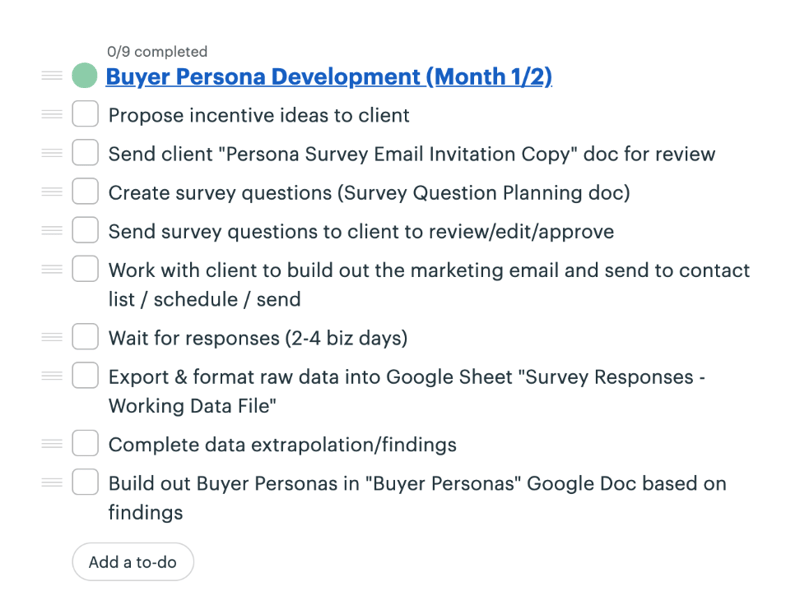
You'll notice that the first step is: “Propose incentive ideas to clients.” Not everybody is going to be open to filling out a survey with nothing in it for them, though, so it's always a good idea to offer some form of incentive. Maybe it's a discount on their next purchase. Perhaps they get put into a draw to win something they'd value. It doesn't have to be much, but it needs to be motivating.
You should also be clear that it isn't a sales email; you're not trying to pitch them anything else. People tend not to enjoy that, so make it abundantly clear that you're simply obtaining information for future use.
Customer Persona Survey Request Email Template
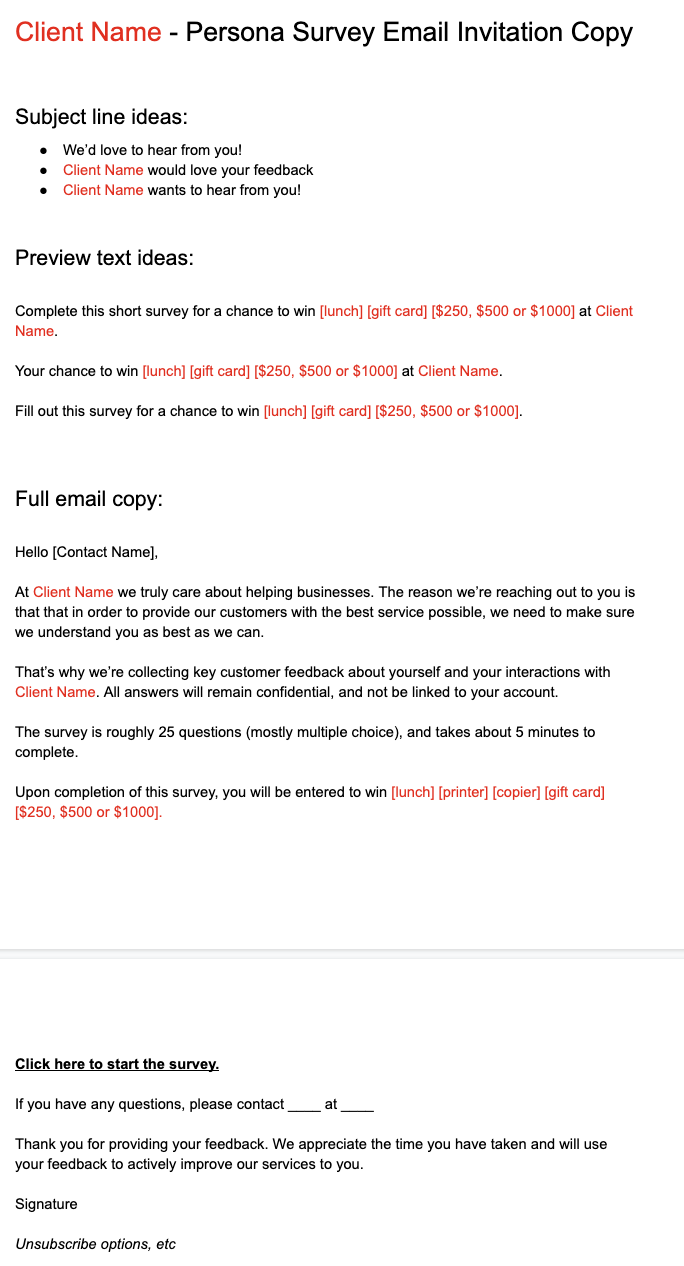
A survey can be a great way to show respect for your customer's time as well. To save you even more time, here's our template for inviting customers to take part in your marketing persona survey:
What To Ask In Your Marketing Persona Customer Survey
You'll want to keep it as short and sweet as possible. Too long, and chances are your customer will switch off and won't complete the survey or just select random options. Keeping the questions multi-choice is a good idea too, but you will need to make sure each question has a purpose - only ask for the information you need.
We typically like to split our surveys into six sections:
- Demographics
- Home/Housing
- Job details
- Watering holes
- Shopping preferences
- Previous purchase with your company
How you go ahead and ask those questions is up to you, but bear in mind that some of the questions you're asking might be considered personal. It's best practice to include a “decline to answer” box and try to keep the survey light and humorous.
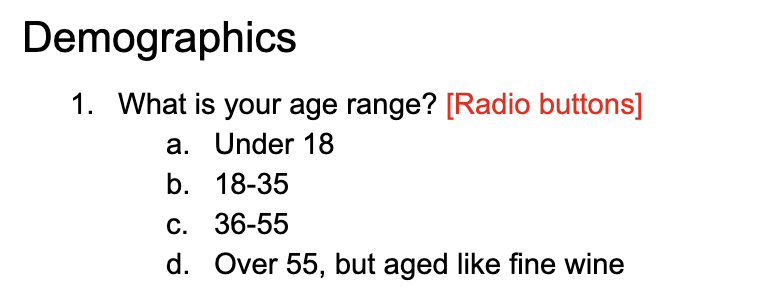
You should try to ask questions about:
- Age
- Marital status
- Children
- Pets
- Gender
- Annual income
- Job title
- Educational background
- Job requirements
- Company size
- Goals and motivations
- Challenges they face
- Social media use (platforms and time spent)
- Other web usage
- Online shopping preferences
- Associations of networks they are involved in
- What influenced their previous purchase with your company
Of course, not all types of questions are going to be suitable for all verticals. If you're in a B2B company, for example, questions about your buyer's company, role requirements, and specific goals and challenges are going to be absolutely vital. These might be less important for you if you're in the B2C space.
Build Out Your Personas
It's time to turn all those numbers into people!
As you continue to collate and analyze your survey results, clear trends and a picture of your typical customer types will start to emerge. Just a heads up, this part is really exciting! If you're close enough to the action, you'll probably even start to recognize some of these trends in your actual customers: “Oh, that's just like James. And Steven!”
Primary and Secondary Personas
Chances are you'll identify two or three subgroups of customers within these results, which is precisely what you want. Let's say you've found two. It's common practice to form a Primary Persona as well as a Secondary Persona. This guides your marketing tactics and decisions; you might put more spending into Primary Persona-targeted ads or perhaps create content that actually applies to both.
Marketing Persona Requirements
At a minimum, your summary should include:
- Occupation or role
- Age
- Income
- Relationship status
- Responsibilities/interests
You might include other information that is specifically relevant to your business. In this example, the client is a home appliances store, so an important section might be to include how often customers update their appliances. Or if you know more about your ideal buyer, like in our persona example above, you may ask them how many homes they design/build each year that will need appliances.
Give Them a Story
Most marketing personas include a little bio or story, which provides a narrative or snapshot of the buyer's key characteristics. Humans are hard-wired to connect to stories, it's how we've passed on knowledge for thousands of years, so this is a fantastic way to help communicate persona characteristics to your team.
Completing Your Marketing Persona
The remainder of your persona document will depend a little on your business, but you should definitely include these three areas:
- Challenges or pain points
- Needs (what they are looking for out of your company)
- Purchasing preferences
Particularly important in creating B2B marketing personas is including a section on Goals. This would focus on what your buyer is trying to achieve in their role (whether they are the company owner, a marketer, or a sales manager).
Knowing what their responsibilities are and what they are aiming to achieve will help you to align your sales and marketing messaging with their goals. If you can show them how your product or service will help them achieve those goals, you've already got a foot in the door.
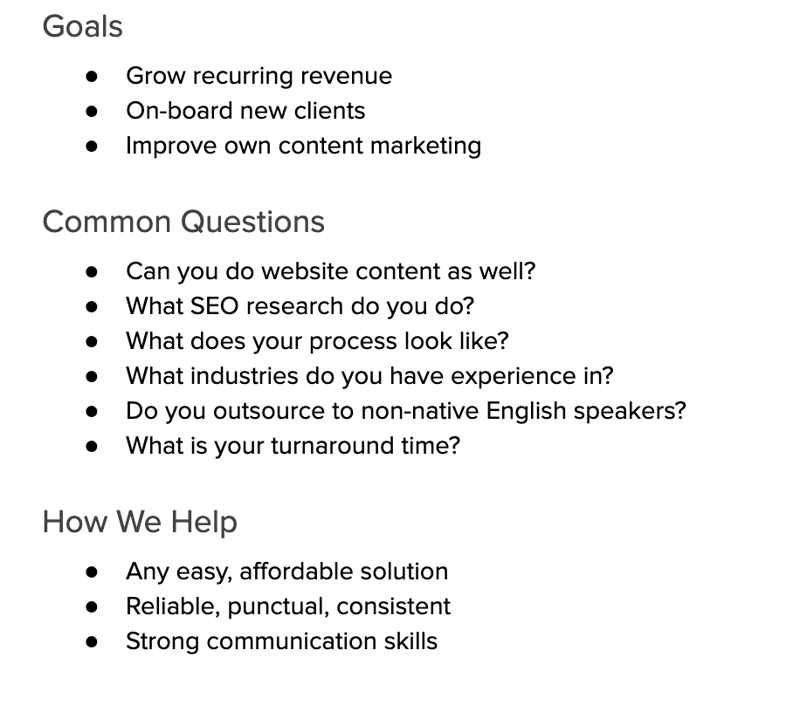
Other helpful areas to include in your marketing personas might be any common questions that particular customer type has, as well as a description of how your company helps them achieve their goals.
Negative Personas
Another highly valuable exercise to complete while you're creating marketing personas is to create a negative persona.
You can't sell to everyone, right? That's the whole point of doing marketing personas in the first place. However, even if your targeting is strong and your marketing efforts are delivering tonnes of quality leads, your sales team still isn't going to close all of them. It's just impossible.
If you can avoid having those “pain” leads enter your pipeline altogether, then you'll be saving your salespeople time and allowing them to focus on leads that are more likely to turn into sales and generate revenue.
An excellent way to identify critical characteristics to form a negative persona is to interview previous prospects who didn't buy from you. This is not a case of trying to find where you can make changes to improve, not that that's a bad thing in itself. Instead, you are trying to understand trends that tell you, "This person isn't going to buy from us."
Let's say you're a SaaS company selling a sales engagement software platform. You're not the only one out there, and so you need to differentiate your product somehow in order to capture a specific audience. So you create Feature A, which nobody else has. But you can't have everything, especially if you want to remain competitive when it comes to cost. So you decided not to implement Feature B.
Chances are, there is a specific characteristic that can be identified in buyers that will eventually decide to go with a different product that does offer Feature B. If you know what that characteristic is, then you can seek to avoid prospects and leads that have it.
2 Persona Marketing Examples
Sophisticated Susan
Working in the financial sector, Susan is a young professional looking to learn about investing. She is looking for ways to save money during the process and wants a company offering the best solution without compromising value.
Demographics
- Age: 24
- Gender: Female
- Location: Silicon Valley, California
- Education: Bachelor's Degree
- Job Title: Financial Consultant
- Income: $70,000 to $120,000 per year
- Family Life: Single but hoping to find a partner within the next five to ten years
Challenges
- She needs to save enough to retire early
- Requires more education on investing
- She is worried about how much money she has to save up and is confused about how to invest it
Needs
- Receive investment advice
- Learn about ways to save money
Top In-Store Purchasing Influencers
- Price
- Brand/Selection
- Customer Service/Experience
Top Online Purchasing Influencers
- Price
- Brand/selection
- Guides and advice
Online Activity
- Facebook, Instagram, Pinterest, Twitter
- Google Search, YouTube
Jovial John
As a happily married middle-aged man who owns a business, Jovial John always looks for new ways to grow his company. Unfortunately, as an organization proprietor, John struggles with a lack of time. Due to these time constraints, he cannot attend conferences and events or perform networking with others.
Demographics:
Age: 43
Gender: Male
Location: New York City
Education: Bachelor's Degree
Job title: Company owner
Income: $100,000 to $200,000
Family life: Married with three children
Challenges
- Requires knowledge to improve his business
- Does not have information on the latest trends
Needs
- Updated articles and content that teach him how to expand the business within the next 10 years
Top In-Store Purchasing Influencers
- Price
- Brand/Selection
- Customer Service/Experience
Top Online Purchasing Influencers
- Price
- Quality content
Online Activity
- Facebook and Instagram
- Google Search
Marketing Persona Template
So, with all this talk about marketing personas and what they're all about, we thought we would include template advice.
Developing a marketing persona template is essential to creating personalized marketing messages that resonate with your audience.
The following are critical elements of a marketing persona template:
- Demographics: Everything about your ideal customer, including location, education, income, gender, and age.
- Psychographics: The client's lifestyle, interests, values, and personality.
- Pain points: What challenges or problems does your prospect deal with daily?
- Goals: Information about what your perfect customer wants to achieve and what are their aspirations?
- Communication preferences: How does your potential customer prefer to communicate with companies, whether it's via phone, social media, or email
- Purchasing behaviour: This includes information about how the person makes buying decisions, including their research process, decision-making criteria, and preferred payment methods.
Once this data is compiled, it can be utilized to create more effective marketing strategies. Businesses can use this marketing persona template to understand different clients' needs and send personalized messages to them. For example, if your marketing persona template identifies your ideal customer as a busy entrepreneur, you can create concise messaging that speaks to their needs.
This extra customer information makes content creation, targeted advertising, and product development more straightforward. If you want to boost your content's effectiveness, be sure to check out our 8 secrets for content marketing.
Extrapolate and Collate
With your survey results in hand, it's time to consolidate that data and make some conclusions about your typical customers.
We've found that the best and easiest way to do this is by dumping all of your data from the survey form into a spreadsheet app such as AirTable or Google Sheets and pulling the data you want out with pivot tables so you can create visually friendly bar graphs.
Below are some examples of the data work involved in creating rock-solid personas, where the business we're creating personas for in this fictional example is a home furniture and appliances store.
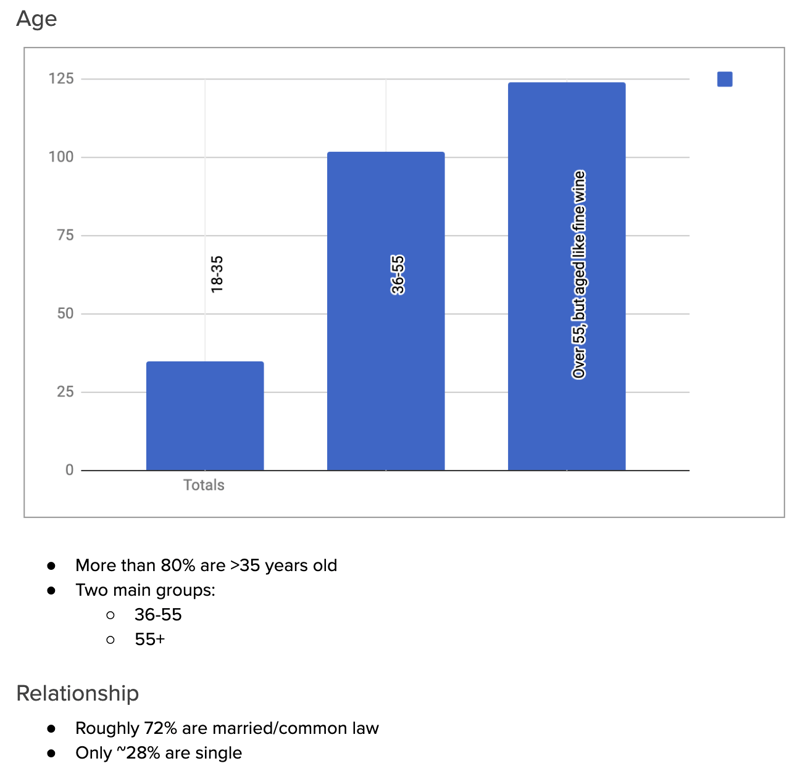
Looking at the above graph, we can clearly see there are two distinct buyer groups: 36-55yo and 55+. Let's dig a little further.
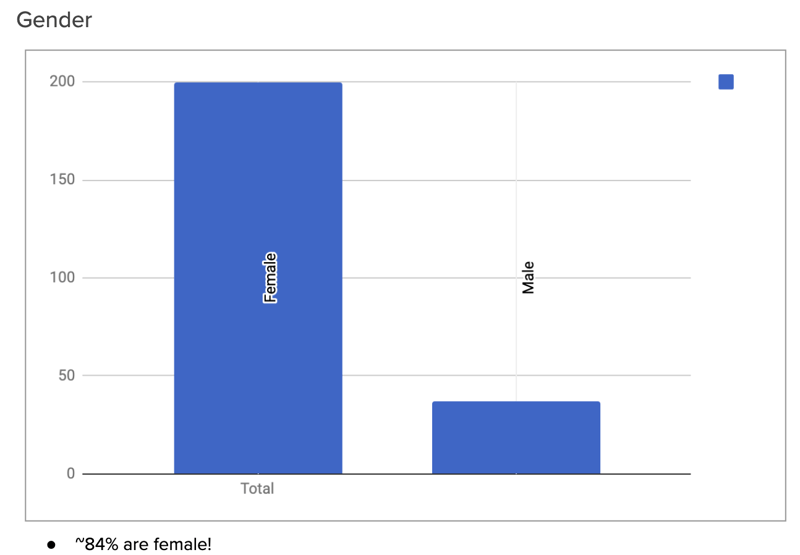
This is an interesting insight. Given over 84% of our buyers are female, we can safely assume this applies to both age groups.
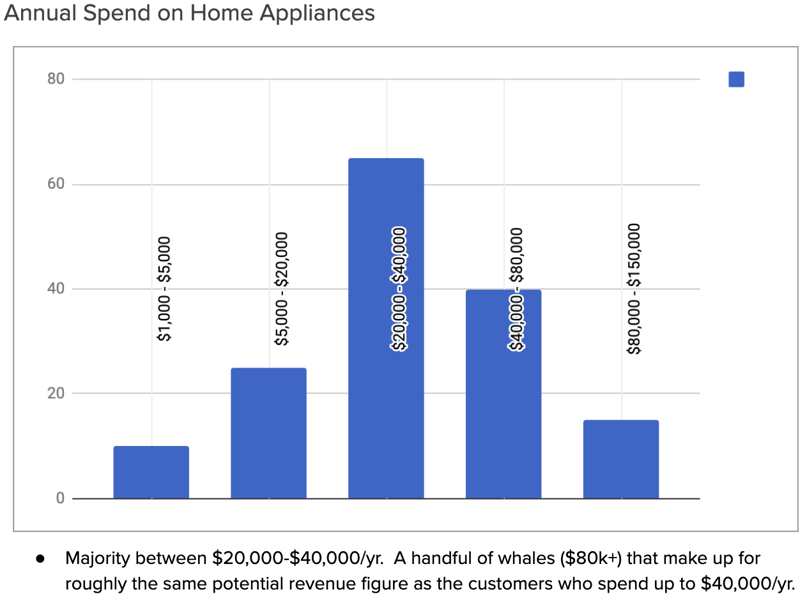
Careful analysis of these figures highlights something of particular interest; this company can earn the same potential revenue by focusing on less than 10% of its total current audience. In creating your marketing personas, it is important to determine whether those ‘whales' are easily identifiable in other brackets.
For example, chances are those big spenders are over-represented in higher income brackets, as well as property ownership and employment type.
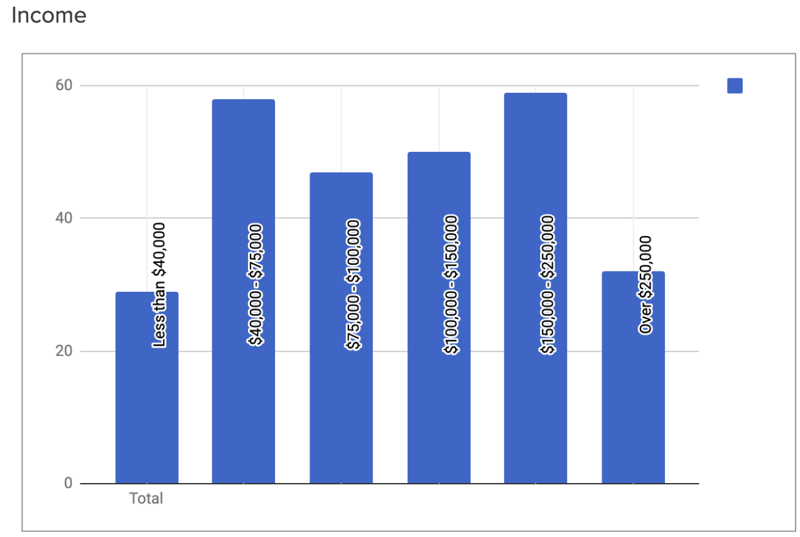
We have a fairly even income distribution, which doesn't seem to have a huge correlation to the average annual spend on appliances.
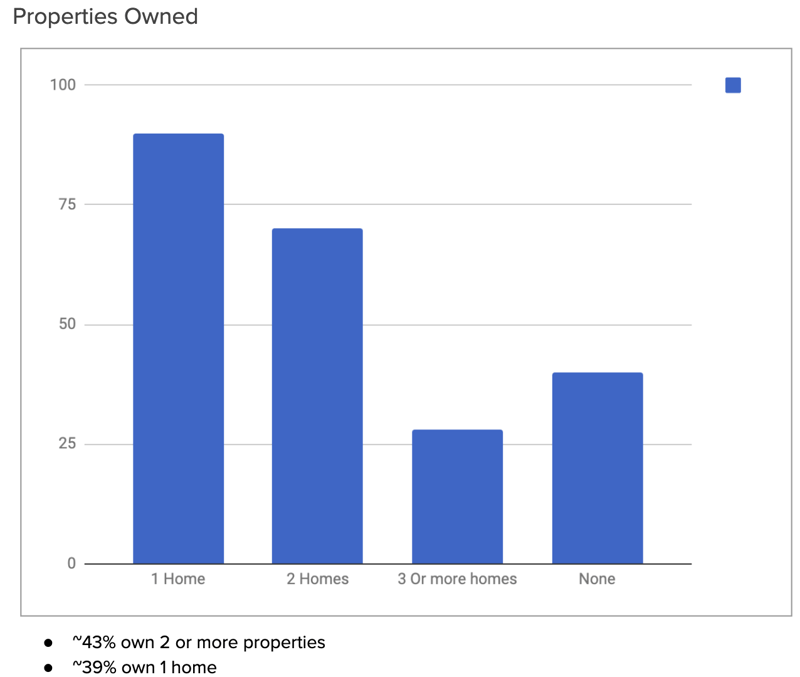
Further analysis of these particular survey results didn't indicate a correlation with any of these factors. In fact, the big spenders were spread fairly equally across all categories. This is an important observation. It's challenging to target big spenders simply on the basis that they are big spenders, as you don't have any other form of information on which to base your marketing efforts!
Using Your Marketing Personas
Once you've got your marketing personas sorted, you should start embedding them in absolutely everything you do. Here are a few places you can begin.
Align Your Email Marketing
I'll never forget something my father once said to me: "There comes a time in every man's life when you stop collecting phone numbers and start deleting them." I'm not quite there yet (single ladies apply below), but it seems an apt metaphor for email marketing campaigns.
One day, you'll get to the point where your email list gets so big you start to think, "Who are all these people, and why are none of them emailing me back?" Chances are it's not the volume that's the problem. Chances are, you're sending the same thing to everyone.
That's not such a problem when you've got 100 emails in your database. When you've got 10,000, though, you need to do something about it. What you need to do is segment your email lists. And the best way to segment them? By customer personas.
Think about it, if you have only three different buyer personas, then any email you send is only relevant to one-third of your list. Now imagine if you have eight. So, consider segmenting your email lists as soon as you have your buyer personas sorted, and start sending relevant, valuable, targeted emails.
Track Personas In Your CRM
Data is king when it comes to making marketing decisions, and one piece of invaluable data to have access to is how your different personas perform. Most CRMs have a field for customer personas, but you can generally add a custom field if not.
With this field created (and a persona assigned for each lead), you can start to ask some helpful questions and answer them using your CRM data:
|
Number of new leads by persona |
|
|
Average deal size by persona |
|
|
Average time to sale by persona |
|
|
Close rate by persona |
|
|
Rates by persona and salesperson |
|
With this information in check, you can draw some valuable insights which lead to well-informed decisions, such as:
- Focus more on Persona A as the average deal size is much higher
- Assign all Persona B leads to Salesperson Y as they work really well together
- Develop your marketing automation campaigns to delivery content you KNOW that particular persona will be interested in and move them down the funnel
Get Leads To Self Identify
Once you've got your marketing persona fields created in your CRM, you actually have your new leads tell you which one they are!
Obviously, you're not going to give them the full details of your personas, but it's a good idea to include a field on your lead forms that asks for some form of identifier.
A typical example is occupation. Let's say you have three personas. Your Primary Persona is a business owner, and your secondary personas are either retired or in some form of management position. In this scenario, you could include a field that asks this question, which would tell you immediately which bucket they go in.
This is fantastic for automated email campaigns, assuming you've followed our advice and segmented your email lists.
Self Identifying Marketing Persona Example
At Roketto, we have several people download our inbound marketing gameplan each day. We ask the simple question, “How would you identify yourself” with the first 2 options aligning with our personas and then some other options afterwards.
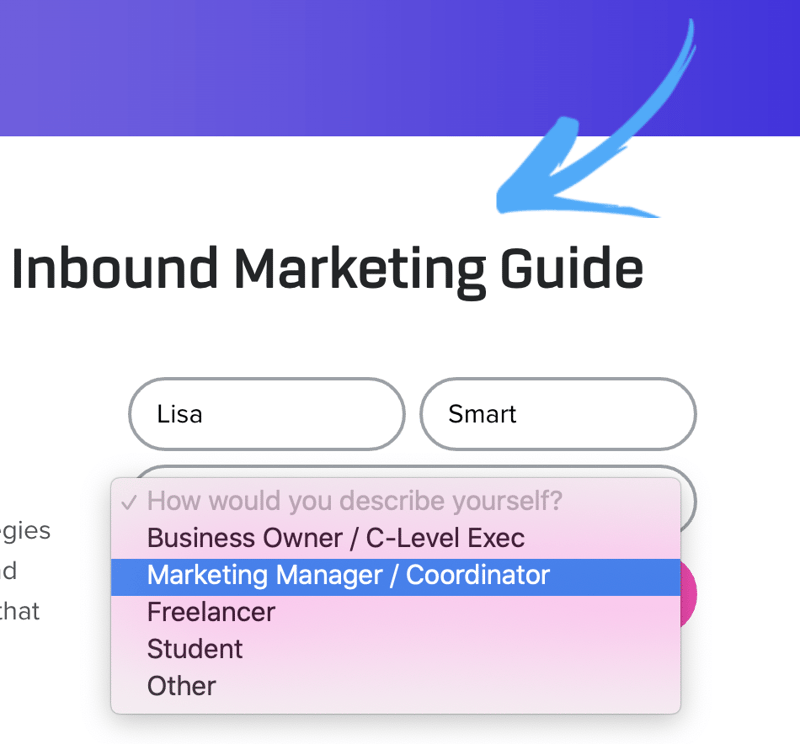
If the downloader matches one of our personas, they are automatically entered into an automated email campaign, where we'll periodically send them more content we think they'll be interested in (and move them down or out of the funnel). If they do not match a persona, we simply let them be.
Conclusion
If there's one thing that's certain, it's that creating marketing personas is no five-minute job, far from it.
You'll need to dedicate hours of your time to planning, interviewing, analyzing, and documenting your findings. Trust us, though; it's time well spent.
Well-crafted marketing personas give you the ability to:
- Boost brand engagement
- Better understand how your leads perform once they're in the funnel
- Create strong, relevant, targeted content
- Improve your email marketing campaigns
- Generate higher quality leads
I can't imagine a single company on this planet that'd decline the opportunity to improve in any of these areas, so you can see why marketing personas are so valuable. Now that the question of “What are marketing personas?” is answered—here's a final word.
We know that it's difficult to find the time to create a marketing persona, so if you're struggling to make space to get started, contact us. We're here to help.

Chris Onyett
Chris is one of the managing partners at Roketto. His area of expertise is digital marketing and loves sharing and educating on topics like Google Ads, CPC bidding tactics, Google Analytics, and marketing automation. When Chris isn't in the office, he enjoys playing volleyball, mountain biking, and hiking with his American Eskimo.












2.png)
2.png)









